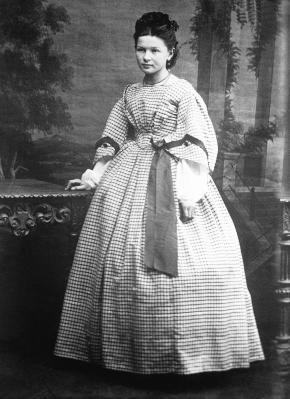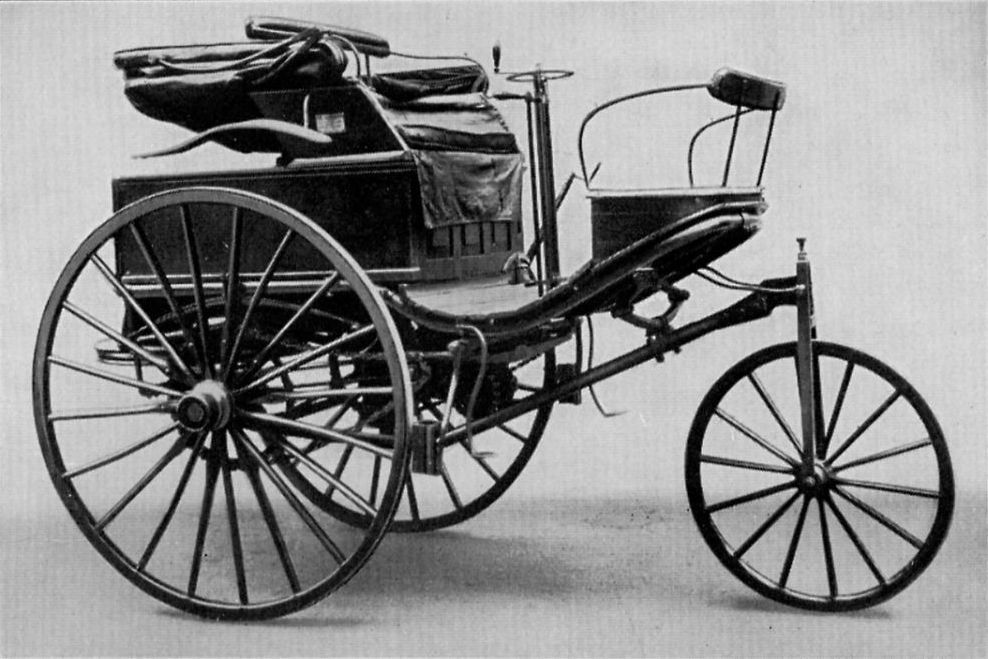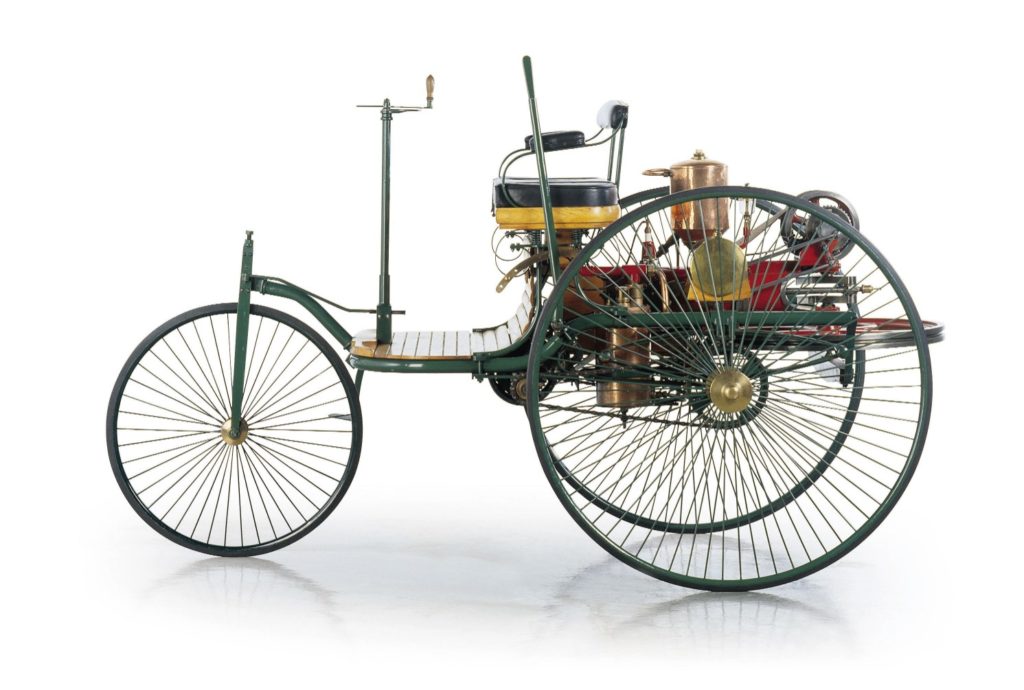We normally think of the development of the automobile to be a male-oriented activity, but it turns out that a wonderful young woman was paramount in the invention and promotion of the first automobile, the Benz Patent Motor Car.
 In 1872 Bertha Ringer married Karl Benz, an internal combustion engine pioneer. The couple used her dowry to finance several different business and manufacturing ventures, most notably Karl’s successful stationary two stroke engine which was introduced in 1879. Seeing the possibilities in combining internal combustion power with then-developing bicycle technology, Karl put his talents to work developing a light weight car. The result, the Benz Patent-Motorwagen (as it was known then), was completed in 1885 and patented in January 1886. It is widely recognized as the first automobile.
In 1872 Bertha Ringer married Karl Benz, an internal combustion engine pioneer. The couple used her dowry to finance several different business and manufacturing ventures, most notably Karl’s successful stationary two stroke engine which was introduced in 1879. Seeing the possibilities in combining internal combustion power with then-developing bicycle technology, Karl put his talents to work developing a light weight car. The result, the Benz Patent-Motorwagen (as it was known then), was completed in 1885 and patented in January 1886. It is widely recognized as the first automobile.
However, even though Karl Benz was a mechanical visionary, he came up a bit short on finding a way to market his invention. Enter Bertha and her pioneering spirit!
Bertha Benz was a truly remarkable young woman, gifted with rare intelligence, curiosity, and analytical ability. She reasoned that the best way to demonstrate the capabilities and possibilities of the automobile was to take the Patent Wagen and drive from Manheim to Pforzheim to visit her mother. Not only would that trip be the first long distance drive in a car, and that she would be the first woman to operate an automobile on such a drive, but she also took along the first passengers – her two teenage sons!
 They set off during August of 1888. Bertha rose to every challenge that presented itself along the way, and there were many! The car had no fuel tank, so when the 4.5 liter supply of fuel in the carburetor ran out she found and bought Ligroin, a type of solvent similar to gasoline, at an apothecary along the way. This essentially was the first “gas station”. She had to use her garter to repair the ignition. She hired a blacksmith en route to repair the drive chain. When the wooden brakes began to fail, she hired a cobbler to nail leather strips to the brake shoes, thereby inventing brake linings. She had to use a hatpin to clean out the fuel line at one point. The car did not have low enough gearing to tackle grades, so her sons had to get out and push the car up hills. The intrepid travelers completed the trip in one full day of driving, and they returned home several days later. It was the first automobile road trip in history!
They set off during August of 1888. Bertha rose to every challenge that presented itself along the way, and there were many! The car had no fuel tank, so when the 4.5 liter supply of fuel in the carburetor ran out she found and bought Ligroin, a type of solvent similar to gasoline, at an apothecary along the way. This essentially was the first “gas station”. She had to use her garter to repair the ignition. She hired a blacksmith en route to repair the drive chain. When the wooden brakes began to fail, she hired a cobbler to nail leather strips to the brake shoes, thereby inventing brake linings. She had to use a hatpin to clean out the fuel line at one point. The car did not have low enough gearing to tackle grades, so her sons had to get out and push the car up hills. The intrepid travelers completed the trip in one full day of driving, and they returned home several days later. It was the first automobile road trip in history!
Their journey created tremendous publicity for the company and for automobile travel in general. From this inspired beginning grew the Mercedes-Benz® automobile company, which kept the Patent Wagen in their historic vehicle collection. Eventually, they donated the Patent Wagen to the Henry Ford Museum in Dearborn Michigan to be displayed to the American public. This first automobile is so iconic that as many as 50 exact reproductions were created and added to prominent car collections across the globe. In fact, The Henry Ford Museum itself added several of these reproductions to its collection, and replaced the original Patent Wagen with one of them in the public display. The original was then put into storage along with additional replicas.
Time passed. Museum management came and went. The Henry Ford Museum collection grew and grew. At some point, the Patent Wagen display was removed, and the reproduction “Patent Wagen” was placed into storage along with the others. Then still more time passed.
In the 1990s, the museum’s management decided it was time to thin the collection. There were duplicate cars, less important cars, and otherwise unwanted cars taking up valuable space, so the decision was made to have an auction to dispose of them. The reproduction “Patent Wagens” were included in these cars to be sold. They were taken out of storage, cleaned up, and made ready for auction.
 Attending the auction was a man named Jasper Wigglesworth. Mr. Wigglesworth is an avid car enthusiast with a special interest in antique automobiles, and he was planning to add one of the reproduction “Patent Wagens” to his collection. Upon inspecting the several “Patent Wagens” for sale, he noticed that one of them had just a bit more real aging of the paint, a bit more authentic wear on the controls and tires, a little more real distress to the wood body, a more naturally ancient appearance to the leather seating. He recognized that the museum had mistakenly mixed up the cars and had put the real Patent Wagen into the sale along with the reproductions!
Attending the auction was a man named Jasper Wigglesworth. Mr. Wigglesworth is an avid car enthusiast with a special interest in antique automobiles, and he was planning to add one of the reproduction “Patent Wagens” to his collection. Upon inspecting the several “Patent Wagens” for sale, he noticed that one of them had just a bit more real aging of the paint, a bit more authentic wear on the controls and tires, a little more real distress to the wood body, a more naturally ancient appearance to the leather seating. He recognized that the museum had mistakenly mixed up the cars and had put the real Patent Wagen into the sale along with the reproductions!

Mr. Wigglesworth somehow contained himself and quietly bid on the lot when it hit the auction block. The bidding closed near $50,000, and the winner was Wigglesworth. He then quietly paid for his purchase, quietly took possession of the car, and quietly loaded it into his trailer for the trip home. Just as he was quietly pulling out of the parking lot, the museum officials, having realized their mistake, ran up to him and pleaded with him to give their priceless automobile back. Mr. Wigglesworth refused by asking them if the situation were reversed, would they have given the car back to him? And so the first automobile in the world, Bertha Benz’s passport into history, and a jewel of the Henry Ford Museum went off in a trailer towed by an old pickup truck to a private collection where it has remained to this day.








I must say after reading this story, my respect for Wigglesworth is pretty low. I think of what my Dad would have done and I have zero doubt he would have happily turned the car back over to the museum. I hope I would have too. Doing the right thing often means foregoing personal gain. That is, financial gain. Imagine how much higher Wigglesworth could hold his head had he done what was clearly the right thing to do. Just my opinion.
Lovely sentiment Steve H., I think also a handshake and looking someone in the eye should constitute” doing the right thing”. very possilble people in the past would have done so. I doubt Henry Ford would have… Mr. Wigglesworth was an opportunist. Rich or poor who knows. today we would call him an entrepreneur. Sorry I am sick of the phrase and its arrogance. God bless him he took advantage of the fools in charge of Henry Fords collection. The true loss was to Benz.
Wow — quite a story. Hard to say exactly how I would have handled the situation. I want to believe I would have done the right thing and possibly asked for one of the replicas at no cost, then given back the Patent Wagen so all could enjoy it in the museum. That way I could go to bed at night with a clear conscience.
I’m afraid that I would have taken advantage of the situation to make a quick profit. I bet the Ford folks would have paid double to get the Wagon back. I would have also negotiated a permanent place in the Ford display for the first auto.
As much as Ford and Ford cars did for America, and the world, I am not an admirer of Henry Ford or the Ford Motor Company.
My first car was a 1929 Model A, which there were many still around when I was a kid, along with plenty of Model Ts.
I think it’s pretty much a toss up as to whether Benz or DeDion was first with a running vehicle, along with other unknown Europeans. Robert Heinlein said something along the lines of, “that when the time comes for a civilization to railroad, it railroads.” Very true of both the railroad, the automobile, the telephone and airplane, to name a few. The Wright Brothers succeeded because they were the first to apply a systematic scientific method to developing propellers, wings, engines, etc.
Well, they don’t build ’em like they used to. Thank God!